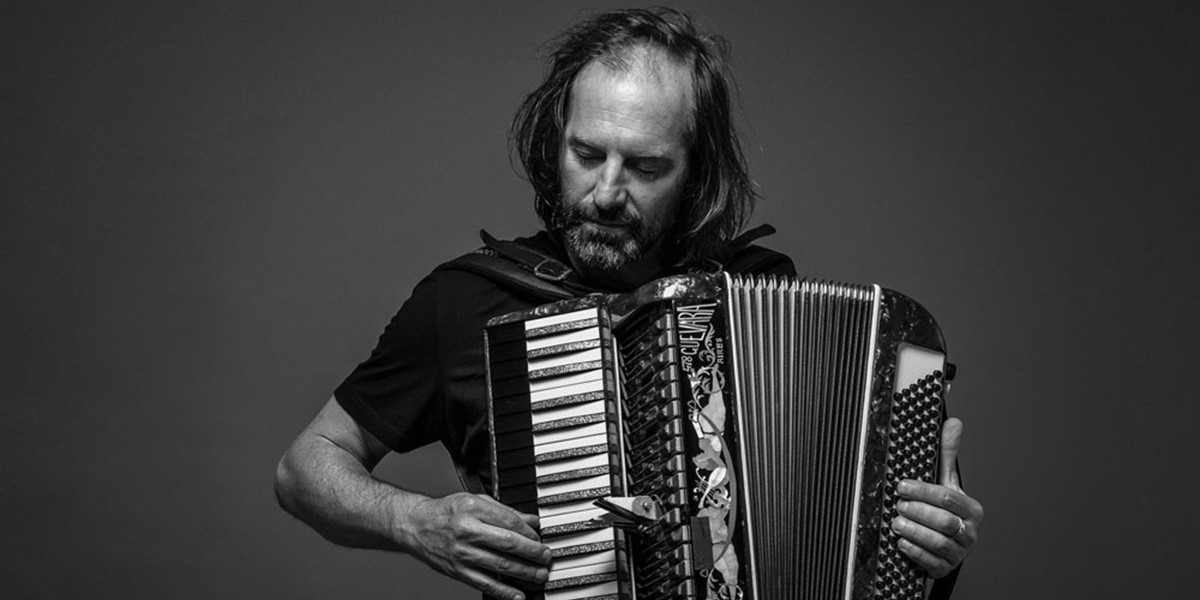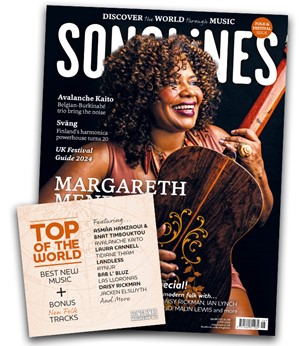Tuesday, June 1, 2021
Chango Spasiuk: A Beginner's Guide
By Chris Moss
Chris Moss shines a spotlight on Argentina’s chamamé music and the career of one of its leading ambassadors, accordionist Chango Spasiuk

Chango Spasiuk (photo: Ignacio Arnedo)
Most people in Argentina are familiar with chamamé, but few listen to it with any regularity. This is partly due to competition from pop music, Latin American dance rhythms, tango and other kinds of folclore argentino. It’s also down to geography. While the Andes, Pampas and Patagonia have established cultural and musical mythologies, the Misiones province in the subtropical north-east is something of an unknown quantity. Most Argentinians visit the region, formerly governed by the Jesuits, once to see the glorious Iguazú Falls, and then probably never go again.
Despite this, on December 16 2020, chamamé was inscribed on the UNESCO Representative List of the Intangible Cultural Heritage of Humanity. While such honours are the outcome of extensive lobbying, the listing is a recognition that the music, while earthy and ‘popular’ – rather than classical or academic – possesses complexity both in its backstory and its expression. ‘Chamamé highlights values such as love for one’s land, local fauna and flora, religious devotion and a ‘way of being’,’ runs UNESCO’s blurb. The existential claim, it says, is a ‘Guarani expression pointing to the harmony between the human, natural and spiritual realms.’
In the Latin American press, Raúl Barboza is also dubbed an ‘ambassador’ of chamamé. But Chango Spasiuk has popularised the form by touring it widely, mixing it up with other musics, and using arrangements that deepen its texture and broaden its appeal. He has also presented to the world a joyous face that somehow reflects the spirit of chamamé. Speaking of the UNESCO declaration, he calls the recognition, “something beautiful… and important for Argentina, a gift, marvellous.”
Horacio Eugenio ‘Chango’ Spasiuk, was born in 1968 in Apóstoles, a medium-sized town in central Misiones. Close to the Brazilian border, it’s a centre for cultivation of yerba mate, green tea-like leaves used to make an infusion popular in Southern Cone countries. At the end of the 19th century, Polish and Ukrainian exiles – some fleeing pogroms in the Russian empire – settled in this corner of Argentina; Spasiuk’s paternal grandfather was a Ukrainian immigrant.
‘While his extraordinary dexterity catches people’s attention, it’s the slow, lulling phrases that provoke an emotional response’
As a child, he has recounted, the Spasiuk family gathered round a “red earth patio” to talk and sip yerba mate, keep as cool as was feasible and play music. His father, Lucas, and uncle, Marcos, ran a carpenter’s shop. When not busy at their craft, the former liked to play violin while the latter sang and played guitar. They were talented enough to play weddings and parties in and around Apóstoles.
This was the setting where chamamé flourished during the first half of the 20th century, in Misiones and neighbouring Corrientes. Its roots entwine African, Jewish and Spanish elements, but the dominant strain is the polka. Songs – originally sung in the region’s native Guaraní language, later in a Spanish-Guaraní hybrid called Yopará – tell of farm life and labour, the seasonal rhythms and childhood, love and death.
Spasiuk was given an accordion – the chief instrument of chamamé – at the age of 12. “I’ve learned to play accordion away from conservatoires,” he says. “Since the day my father gave me my first instrument, I’ve never stopped playing it.” He soon mastered the squeezebox and standards by pioneers like Isaco Abitbol, Tránsito Cocomarola, Blas Martínez Riera and Ernesto Montiel, and became a regular on a local TV show dedicated to chamamé.
In 1989, Spasiuk was a hit at the Cosquín Festival, Argentina’s biggest folk event, and released his rough and ready self-titled debut. The following year he moved to Buenos Aires. His childhood was passed at a time of political convulsions (the return of Juan Perón, the dirty war) and musical revolutions (Dylan, the Beatles, Argentinian rock nacional). He was also – inevitably – the heir of two Argentinian mould-breakers: nuevo tango superstar Astor Piazzolla and Atahualpa Yupanqui, Argentina’s foremost folk legend.
In the capital, Spasiuk played live alongside Barboza and recorded a second album, Contrastes (1990). For the follow-up, Bailemos y… (1992), he reached across the border to explore Brazilian folk. The independently produced La Ponzoña (1996) was followed by two discs for BMG: Polcas de mi Tierra (1999) and Chamamé Crudo (2000), which featured a duet by Mercedes Sosa and Victor Heredia. The Charm of Chamamé (2003), on Germany’s Weltwunder record label, contained tracks from the last three discs and helped introduce Spasiuk to a European audience.
Spasiuk has since released six further albums and performed to rapturous audiences in Asia, the US and across Europe. He has played jazz, world and traditional music festivals, and collaborated with a great range of artists, including Kronos Quartet, Kepa Junkera, Carlos Núñez and Lila Downs.
In 2014 he had his debut at Buenos Aires’ Teatro Colon, a rite of passage for Argentinian artists who want to be taken seriously. Spasiuk is ambivalent about being regarded as an experimentalist or innovator. He told Spain’s El Mundo newspaper, ‘I don’t want to be a virtuoso, I’m interested in ideas.’ On records and at shows, he combines playful polkas with multi-movement art pieces. While his extraordinary dexterity catches people’s attention, it’s the slow, lulling phrases that provoke an emotional response.
He has worked hard to explain, to ignorant journalists, that chamamé is a musical tradition in its own right. “[It has] no relation with forró, from the Brazilian north-east, no relation with tango,” he says. “Chamamé is rural, tango urban.”
It is also a living tradition. Misiones is still rural, its economy dependent on lumber, fruit, tobacco, sugar cane, rice and yerba mate. Chamamé for misioneros remains a music of the earth and a dance of intimate embrace. Chango Spasiuk has always honoured these two principles. “I think there is a difference between searching for beauty and entertaining yourself – yet they can be the same,” he says. “And I am trying to play, leaving space for things to happen, so my head stops functioning and I am just playing and leaving space for something of a subtle spiritual quality to come in.”
BEST ALBUMS
Contrastes
(Música & Marketing, 1990)
From the violent version of Raúl Barboza’s ‘Tren Expreso’ to the raucous ‘As de Basto’, this disc of eight covers and two original songs by Spasiuk and singer Jorge Suligoy gave Buenos Aires an early glimpse of a new folk hero come to town.
Polcas de mi Tierra
(Acqua Records, 1999)
Recorded live in towns and villages across Misiones during the religious fiestas of St Peter and St Paul, this sequence of 36 short songs is akin to an oral history of chamamé. It won a Premios Gardel award – like an Argentinian Grammy – in 2000 and was re-released by BMG in 2004.
The Charm of Chamamé
(Weltwunder, 2003)
An excellent compilation that samples the sprightliest songs from La Ponzoña (1996), Polcas de mi Tierra (1999) and Chamamé Crudo (2000). In our review (January/February 2004, #22), Jan Fairley called it a ‘groundbreaking work by a significant musician.’
Tarefero de Mis Pagos
(Piranha, 2004)
On his first international release, Spasiuk covers the gamut of feeling in songs that find him testing the sonic range of his accordion. It got a Latin Grammy nomination, won Spasiuk the Newcomer award at the BBC Radio 3 Awards for World Music and also a Premios Gardel award. A Top of the World in the January/February 2005 issue (#28).
Hielo Azul Tierra Roja
(Reckless Records, 2019)
A collaboration with Norwegian guitarist and composer Watle that shows Spasiuk’s continuing drive to push chamamé in new directions; energetic tunes and contemplative ambient duets generate heat and light, cold and shadow.
This article originally appeared in the May 2021 issue of Songlines. Never miss an issue – subscribe today

